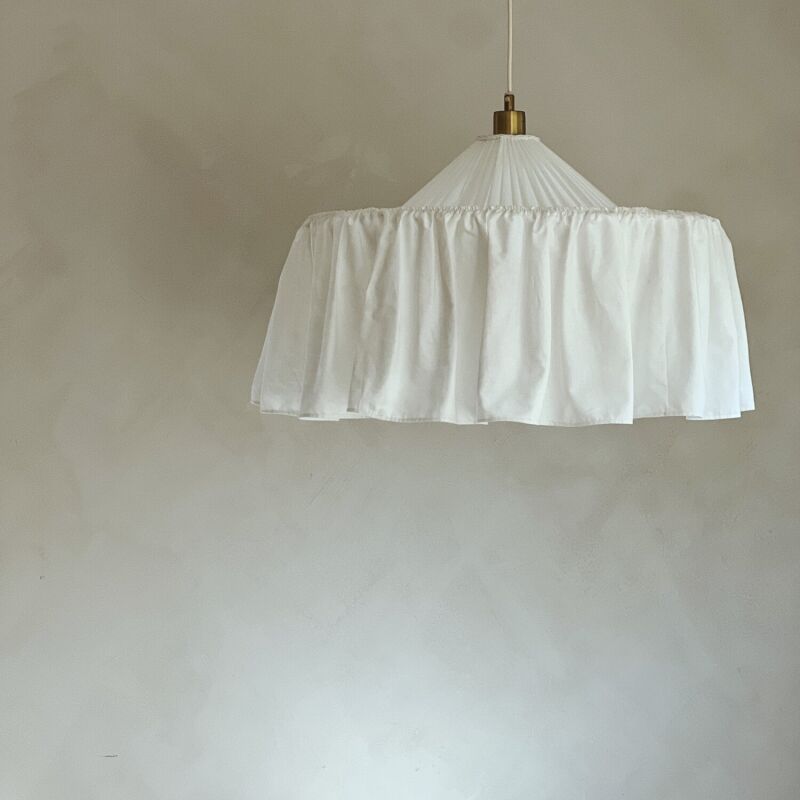This week we’re revisiting some of the most popular DIY stories from our archives. Read on for end-of-summer project inspiration:
For a long while I’ve been eyeing knife-pleated lampshades, wanting a couple of my own. Then I realized I could make one myself with a thrifted shade, a swath of fabric, and not much else. Total cost? About $12.
Here’s how.
Photography by Mel Walbridge for Remodelista.
Supplies

Here’s what you’ll need:
- Lampshade (I found several at Goodwill for $2 each; it’s okay if they’re a little blemished.)
- Fabric, plain or patterned (a mid-weight fabric that isn’t too thin but also folds well works best; I used simple cotton.)
- Fabric scissors
- Needle and thread or fabric glue (I used Bish’s Original Tear Mender, a US-made instant adhesive; note that this is best for dark and patterned fabrics only, as I learned it shows through light fabrics after a while.)
- Optional: spray starch or homemade starch (1 tablespoon flour mixed with 1 cup cold water) and paintbrush
- Yard stick or ruler
- Clip
- Straightener or clothes iron
1. Measure the fabric.

2. Hem the edges.
3. Coat with starch (optional).

4. Accordion-fold, an inch at a time.

5. Iron the creases.


6. Wrap the cloth around the lampshade.

7. Match and glue the seams.

8. Adhere pleats to the top.
The Finished Product


For more DIYs, see:
- Salvaged Style: An Easy DIY Upgrade for Dry Cleaner Wire Hangers
- DIY: Easy Ceramic Votive Holders for a Festive Table
- DIY: A Summery Side Table by Two Young Paris Architects
N.B.: This story is an update; it originally ran on April 17, 2023.
Frequently asked questions
What is a pleated lampshade?
A pleated lampshade is a lampshade that has folds or creases known as pleats. These pleats add texture and visual interest to the lampshade.
Can I make my own pleated lampshade?
Yes, you can create your own pleated lampshade using the instructions provided in the post. It is a DIY project that allows you to customize the lampshade to your liking.
What materials do I need to make a pleated lampshade?
To make a pleated lampshade, you will need fabric, lampshade rings, a lampshade frame, adhesive, scissors, a ruler, and a pencil. The specific materials and measurements are detailed in the post.
Is sewing required for making a pleated lampshade?
No, sewing is not required for making a pleated lampshade following the instructions provided in the post. The fabric is attached to the lampshade rings using adhesive, eliminating the need for sewing.
Can I use any fabric for making a pleated lampshade?
You can use a variety of fabrics for making a pleated lampshade, but lighter fabrics with some stiffness tend to work best. Fabrics like linen, cotton, or lightweight upholstery fabric are often recommended.
Are pleated lampshades difficult to make?
The difficulty level of making a pleated lampshade can vary depending on your crafting skills and experience. However, the instructions provided in the post are detailed and should be easy to follow for most DIY enthusiasts.
Can I customize the size of the pleated lampshade?
Yes, you can customize the size of the pleated lampshade by adjusting the measurements and proportions of the fabric and lampshade rings. The post provides guidance on how to calculate these measurements.
Are pleated lampshades suitable for all lamp types?
Pleated lampshades can be used with various lamp types, including table lamps, floor lamps, and pendant lights. However, it is important to ensure that the lampshade frame and rings match the size and shape of the lamp you intend to use.
Can I wash or clean a pleated lampshade?
The cleaning method for pleated lampshades depends on the fabric used. Some fabrics may be spot-cleaned, while others may require professional cleaning. It is recommended to refer to the care instructions for the specific fabric used.
Where can I find additional inspiration for pleated lampshades?
You can find additional inspiration for pleated lampshades by exploring home decor magazines, websites, or platforms like Pinterest. They often feature various styles and designs to help you discover unique ideas.










Have a Question or Comment About This Post?
Join the conversation